|

|
April 2004
|
CHIEF OF THE NAVAL STAFF REVIEWS SUBMARINE OPERATIONS
|
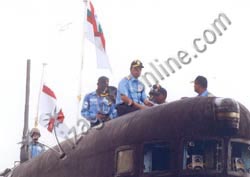 |
| Admiral Madhvendra Singh, the Chief of the Naval Staff who is currently on a visit to Visakhapatnam to chair the Annual Commanders Conference from 27th to 29th Apr 04, sailing onboard INS Sindhuvir to review submarine operations on 26 Apr 2004. |
|
Admiral Madhvendra Singh, PVSM, AVSM, ADC, the Chief of the Naval Staff who arrived here on Sunday to
chair the Annual Commanders Conference from 27th to 29th Apr 04, spent a day-at-sea by sailing onboard
INS Sindhuvir, a frontline submarine of the Eastern Naval Command. The Chief of the Naval Staff reviewed
submarine operations which were conducted off Visakhapatnam today. Captain S.
H. Subramanian, Commodore Commanding Submarines of the Eastern Region accompanied the Chief of the Naval Staff during the
day-at-sea programme. The submarine, INS Sindhuvir is commanded by Commander Raghawendra
Rai. The Chief of the Naval Staff later in the day visited various naval establishments and the Naval
Maritime Academy functioning under the aegis of the Eastern Naval Command.
Meanwhile, Vice Admiral Arun Prakash, the Vice Chief of the Naval Staff, Vice Admiral Madan Jit
Singh, the Flag Officer Commanding-in-Chief, Western Naval Command, Vice Admiral Yashwant Prasad, the Flag
Officer Commanding-in-Chief, Southern Naval Command, Vice Admiral P. Jaitley, the Chief of Material, Vice
Admiral S.V. Gopalachari, the Deputy Chief of the Naval Staff and a large number of other Flag and Senior
naval officers from all over the country arrived in the city for taking part in the three-day long Naval
Commanders conference commencing from Tuesday, 27th April. Vice Admiral O.P. Bansal, the Flag Officer
Commanding-in-Chief, Eastern Naval Command hosted a banquet in honour of the Chief of the Naval Staff and
the visiting dignitaries today.
|
|
|
|
NAVAL DOCKYARD DEVELOPS POLLUTION CONTROL DEVICE FOR HEAVY VEHICLES
|
|
A team of five service and civilian personnel of the Naval Dockyard, Visakhapatnam, achieved a remarkable success by designing and developing a device for combating vehicular pollution. The team, led by Lieutenant Commander Mohinder Singh, Manager Dockyard Transport modified the exhaust system of a heavy duty
diesel vehicle of three-tonne capacity by adopting innovative and indigenous techniques. The
fitting of the device has resulted in considerable reduction in two of the vital
automobile pollution levels, namely the Smoke Density and the Light Absorption Coefficient or the "K" value. The device
that was developed in-house brought down both the pollution levels to as
much as fifty percent and showed sustained performance when the vehicle was subjected to various temperatures and different road conditions in a 400
km run.
The Flag Officer Commanding-in-Chief, Eastern Naval Command and the Admiral Superintendent Naval Dockyard, Visakhapatnam, complimented the team for its commendable efforts in addressing vehicular pollution which
affected the environment and public health adversely. The Transport Department of Andhra
Pradesh, reputed engineering and environment experts have appreciated the team's effort. Lieutenant Commander Sardar Singh,
highly skilled workers M. Rama Rao, H.S.B. Raju and N.V. Sree Ramam of the yard are the other members of the team.
The yard now intends to get the device tested and certified by
Government approved testing agencies including the Vehicle Research Development Establishment of the Ministry of Defence for further development and progressive implementation. The yard has already applied for
a grant of patent right of the
device. The pollution control device contains a chemical solution and incorporates special design features to avoid back pressure on the engine and corrosion of internal components. The system utilises kinetic energy of
the exhaust gases to achieve swirling and scrubbing effect resulting in cooler and cleaner emission. The effluents formed during the process are
harmless and easily disposable. |
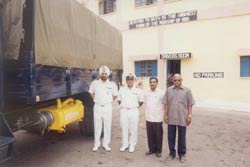 |
| Lieutenant Commander Mohinder Singh, (extreme left) Manager Dockyard Transport and the leader of the team along with members who designed and developed a pollution control device for heavy duty diesel vehicles standing next to a 3-tonne capacity heavy
vehicle (fitted with
pollution control device) . |
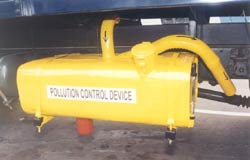 |
| A pollution control Device, developed by the Naval Dockyard, Visakhapatnam, fitted in the exhaust line of one of the heavy vehicles of the Eastern Naval Command. |
|
|
|
|
POOR HARVEST TO MAKE MANGOES DEARER
|
|
Early season green mango prices have touched the highest ever - Rs 18,000 a ton this season - as against normal rates ranging between Rs 5,000 and Rs 7,000 a ton. Vizianagaram mango growers sold three truckfuls of mangoes weighing 27 ton on Wednesday at the rate of Rs 19,000 per ton to wholesalers at Rayagada. The three-fold increase in the price is owing to untimely rains and fog beyond February, which had caused the falling of mango bloom. The Banginapalle variety is yet to arrive in the market, but farmers don't expect to produce much, and are geared up for a crop slump owing to bad weather.
|
|
|
INS DARSHAK RECOVERS 200 YEAR OLD CANNON FROM SEABED
|
|
INS Darshak, hydrographic survey ship of the Eastern Naval Command recently accomplished a major project of exploring submerged wrecks off Tamil Nadu having great historical significance. The exploration was part of the endeavour of the Naval Headquarters to gain more authentic knowledge of our maritime history. The project for exploring the submerged remains of
the lost city of Poompuhar with the aim of reconstructing the maritime history of Tamil Nadu was tasked to INS Darshak. |
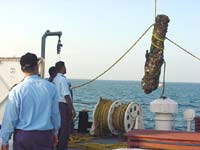 |
|
The naval ship, commanded by Captain P Jayapal, was deployed off Poompuhar, about 15 nautical miles north of Nagapattinam since the end of February '04. The ship carried out extensive hydrographic survey and diving operations in the area off Tharangambadi (formerly known as Tranquebar) coast. During the operations that lasted for nearly a month, the ship recovered a few
prominent objects of archaeological importance. An U-shaped structure, located 3 miles into the sea at a depth of 23 metres was discovered during one of the dives. The structure was 85 metres in peripheral length, about 2 metres in height and the distance between the arms was about 13 metres. The structure was covered with marine growth and the centre was
buried under silt. The opening was to the north of the structure and 40 meters to its north were two pillar shaped structures. Local fishermen claimed that the structure was one of the six such temples submerged underwater.
The ship also recovered a shipwreck supposed to be a Dutch ship sunk by the French during the end of 18th century. On carrying out dives over the structure, three lead ingots about 1m long and weighing approximately 80 kgs each were recovered. The markings on the ingots were "W.Blackett" which was
the name of a British company that manufactured it and the marking of "1792" was presumably the date of manufacture. Moreover, the ingots carried an inscription 'Vior' in a heart-shape, which was the emblem of the Dutch East India Company.
|
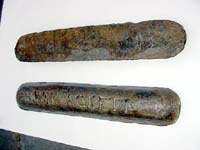 |
The naval divers from the ship carried out extensive diving at the site and identified a two-metre long cannon deeply embedded in the seabed, which was fastened to a structure on the wreck. The ship's diving team carried out airblasting to remove the sediments and expose the cannon. The ship then
executed a daring manoeuvre on top of the wreck and hauled out the cannon from the seabed using a combination of the lifting gear available onboard. This operation was a very difficult task compounded by adverse sea conditions and was a test to the efficiency and skill of the ship's staff as the ship is not equipped to carry out excavations of such
nature. The cannon, which was covered with extensive marine growth was 2.1 meters in length, 50 cm diameter and weighed approximately 700 kgs. |
|
|
The recovery of large and valuable objects of archaeological importance from such depths at sea marks the beginning of a new chapter in marine archaeological explorations in the country. The Indian Navy is committed to carrying out such projects with the aim to reconstruct our glorious maritime
history. The Naval ship had since reached the home port, Visakhapatnam in early April along with the highly valuable artefacts.
|
|
|
Cruise boats soon to enthral Vizag tourists
|
|
Good news for Vizagites looking at extra thrills during the weekend - coastal cruise along the state and its neighbouring coasts will soon be introduced by Andhra Pradesh Tourism Development Corporation (APTDC), with boats taking off from Vizag. Even the Centre has pitched in with 25 per cent stakes in the project.
The department will make the best of rising demands for aquatic entertainment and travel, starting with state-of-the-art ferries to take people to the neighbouring sea towns of Chennai and Kakinada, APTDC vice-chairman and managing director C Anjaneya Reddy said recently, as he came down to Rushikonda to inaugurate the new conference hall there. |
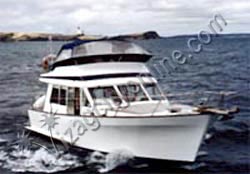
|
|
|
A senior consultant is already working on the project report for the scheme to be launched soon, he added. The port has already offered an exclusive jetty where the first few boats would take tourists a few kilometres into the sea.
A 150-room beach resort at Rushikonda, especially designed for foreign tourists, is also on the anvil. APTDC will also take upon itself the task of keeping the city beaches clean, relieving VMC. Fifty more rooms would augment the existing facilities at Rushikonda. Mayuri, at Araku Valley, will be replaced by a newer and more modern project. A special Araku-bound tourist train will soon run from Vizag, and the Railways department is already redesigning its coaches. Travelling on this train, tourists would be able to feast their eyes on the Eastern Ghats.
VUDA vice-chairman D Srinivasalu had even more avante garde suggestions to make - a sea swimming pool, while attracting tourists, would ensure their safety as well, he said.
Parasailing and boat rides too will be part of this fun-packed holiday season. At the fishing harbour, a trained paratrooper waits to assist people in the derring-do which comes at a cost of Rs 300 for a 10 minute-glide in the air.
|
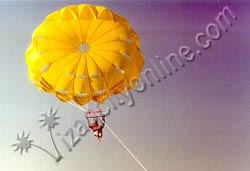 |
At the Rushikonda beach, two types of boats, deluxe and speed, are waiting to take you out to the sea. A ride in the deluxe boat costs Rs 25 for an adult and Rs 15 for a child for a round that covers a 3 km radius. A one-hour ride costs Rs 130. Safety arrangements include providing of safety jackets besides the deployment of experienced swimmers and life-guards to cope with emergencies.
The VUDA has also pitched in to provide summertime entertainment. An old ship is being renovated for ride from the jetty to Bheemli and back. The tariffs are yet to be fixed but the cruise would be launched before the commencement of the summer vacations in schools.
Howzzat, Vizagites? |
|
|
|
ENC team returns after rafting expedition:
|
|
A contingent of fifteen officers and sailors of the Eastern Naval Command which undertook
the "White Water Rafting Expedition" on the river Alaknanda from Rudraprayag to Rishikesh from
the 23rd to the 26th of March, 2004, returned to the Naval Base, Visakhapatnam on Friday,
the 02nd of Apr '04 after successfully completing the mission. The expedition team members were given a warm welcome on their arrival by Commander
R. B. Menon, officiating Commanding Officer of INS Virbahu, the premier submarine support establishment at Visakhapatnam.
The naval team completed nearly 160 km of rafting in the downstream of the river
using two inflatable rafts, negotiating numerous high speed rapids and
traversing the check points at Srinagar, Devprayag, Kaudilaya and Shivpuri. The team leader, Lieutenant Commander
M. R. Dagar, a highly experienced naval officer who has been on similar expeditions
in the past, described the recent rafting expedition as being unique in many ways. He said that for the first time a bigger contingent of the Eastern Naval Command, all from Visakhapatnam, had embarked on this type of expedition, considering its
popularity as one of the prime waterborne adventure activities promoted by the Indian Navy. Secondly, the team encountered highly challenging moments while undertaking the activity, which included the high grade rapid - "The Wall" and other dangerous manoeuvres such as Daniel's Dip, Three Blind Mice, Roller
Coaster etc. The naval team navigated the Wall successfully this season, while the
other participants flipped, despite the fact that most of the members were
novices.
The success was attributed to the rigorous pre-embarkation training at Rudraprayag.
Other participants in the expedition included Sub-Lieutenant Supradeep, the only other officer member and sailors Kalyan Singh,
M. D. Sharma, V. K. Gupta, D. Kumar, L. B. Shreshta, Prashant R. Chandra, S. Haldher, A. Parashar,
A.S. Negi, P. K. Solanki, P.S. Negi and S. Singh, all enthusiastic volunteers from the naval ships INS Khanjar, Konkan, Kora, submarine INS Sindhuvir and the shore establishments INS Virbahu and Submarine Maintenance Unit.
|
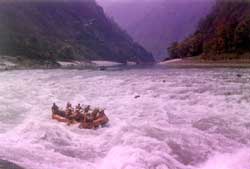 |
| Rafting1: The Eastern Naval Command team negotiation a high grade rapid during the Water Rafting Expedition recently undertaken by them on Alaknanda River from Rudraprayag to Rishikesh. The team retuned to the Naval Base, Visakhapatnam on 02 April 04. |
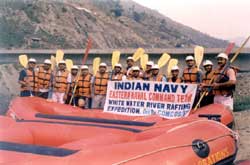 |
| Rafting2: The Eastern Naval Command team which undertook Water Rafting Expedition recently on Alaknanda River from Rudraprayag to Rishikesh assembling with necessary gear prior to embarking. The team retuned to the Naval Base, Visakhapatnam on 02 Apirl 04. |
|
|
Back
|
|








